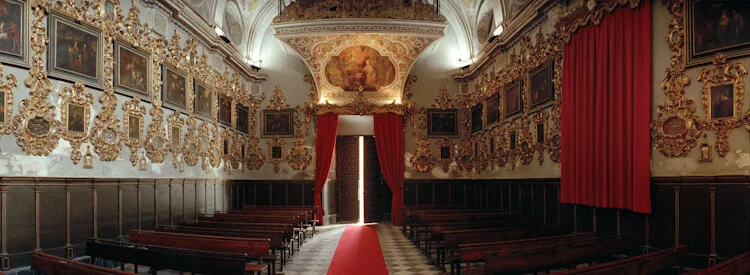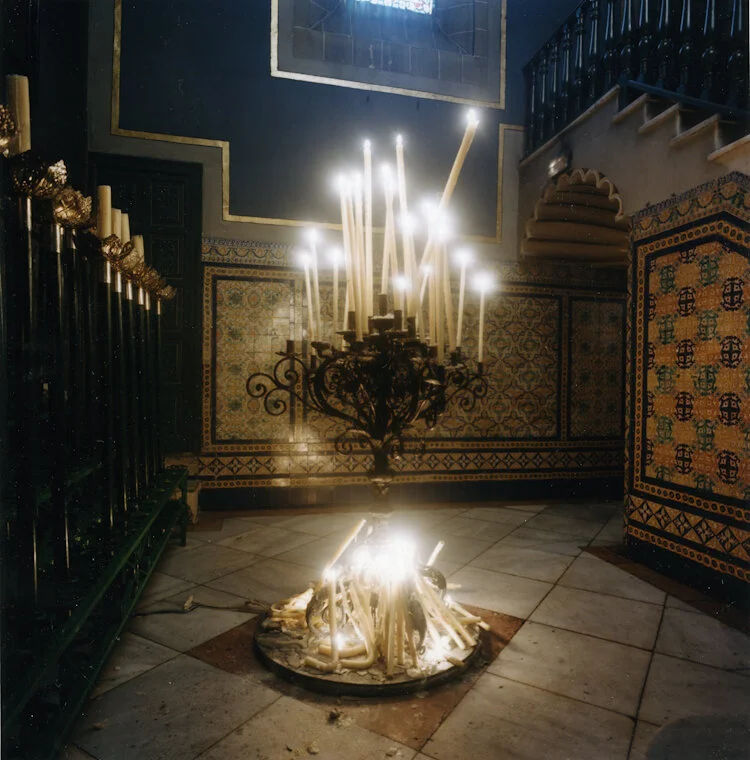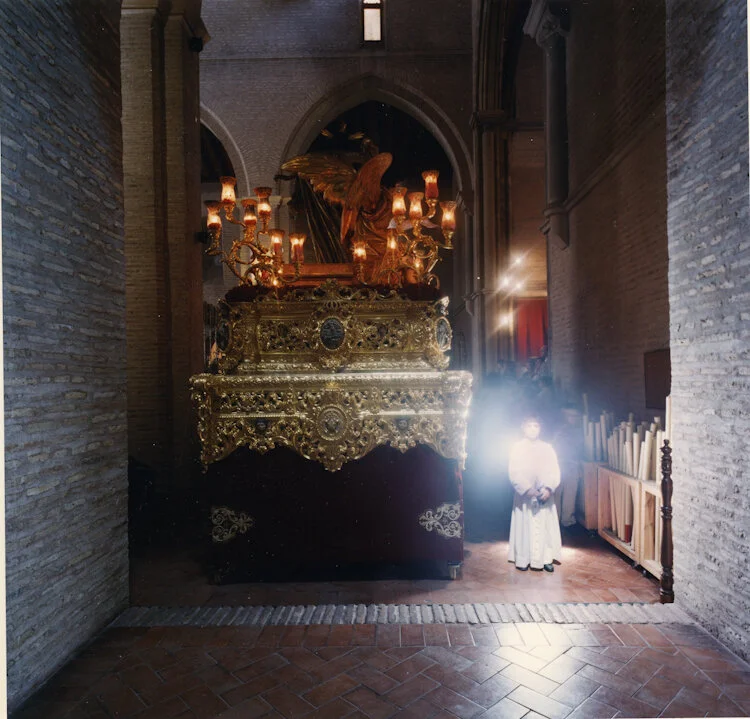SACRED SEVILLE
3 a.m., Seville, Southern Spain, Semana Santa–The black Spanish sky merges with the darkened vault of the Iglesia de Santa Marina. Inside the church, he waits patiently with his mother. He is 7 years old. His mother fusses with his cape– white, pressed, reflecting in the candlelight. The candle is slightly smaller than he is. The 3-foot wax cylinders touch against the neighboring capes in the sleepy confusion of the early morning hours, adding an element of risk to the austerity of reverence. His fastidious mother straightens the pleats of his robe, adjusts his braided belt and finally, as the procession begins, she assists the placement of his peaked hood upon his small shoulders. Ultimately, his eyes find the horizontal cat-like slits and he is ready. “One man’s feast is another man’s poison.”
This adage takes form in comparing the pointed hats of this very Catholic ceremony to the robes of the Ku Klux Klan as they change polarity and meaning, traversing an ocean. This is the culmination of Easter week. It starts with such celebrations as Carnival Janeiro and Mardi Gras in New Orleans. This is the culmination of the Lenten season that begins in February and ends in the processions of Southern Spain in mid-April. Just ahead of the boy is a man: 25, stronger, dressed in a turban whose neck shield is is embroidered with the Madonna. He takes his place under the paso with the other 50 men. At the three sharp reports by the major domo on the front of the float, the hundreds of pounds of gold, silver, candle and flame are thrown into the air and vibrate to a singular moment on the backs of the men as the doors of the cathedral open and the Christ paso is framed, silhouetted by the streetlights beyond the arches. Slowly the processional moves forward into the night. The Christ, followed by the wave of candle-bearing penitents, crawls silently by. The paso of the Madonna, awash in the light of hundreds of candles from below, looks down upon the devoted thousands in the streets praying as the parade goes by. pulsing through the narrow arteries of Seville. At each corner the float must carefully negotiate and maneuver with the control of the major domo leading the blind bearers below the float. Each hundred paces the paso halts, the men rest, their necks bleeding, raw from the weight of the reverence they bear. The plumes of the centurions cast feathered shadows from candlelight on the ochre walls framing both sides of the serpentine passage. The armor of the men glistens with the labor of the year’s polishing in anticipating this night of glory. The bell and the incense activate every sense as the paso continues with the sun’s rise. The streets allow little forgiveness for the casual observer. There is no room for the uncommitted. With a 15-foot wide float turning corners on streets barely 20 feet across, the viewers must give full attention. The hierarchy of leadership of the church controls the pace and navigation of the passage through the masses. The dawn’s light adds to the shadows, to the magic light dancing.
A warming sun wrestles with the light of the candles for dominance, making the mid-April day begin to cook uncomfortably. The processional stops as a formally dressed matron, mantilla framing her face, looks down on the Virgin and sings carefully, clean, precise and passionate words, the crying of a woman who understands pain and suffering. It is the emotion only another woman can feel and share the loss of a son. The floats throb onward, moving, resting, milling, shuffling slowly forward. Ten a.m., noon, 2 p.m. the candles have not noticeably diminished in height, but the hoods and capes have lost some of their crispness from the coolness of the evening. Still the procession pulsates forward. The Madonna, Christ and attendants of all ages approach the entry after 12 hours’ march, returning to the welcoming Iglesia de Santa Marina. Finally the processional is met by a lone man. He is 47 years old, formally dressed on a balcony overlooking the church entryway. The arrival is marked by a hush among the masses. The vacuum of silence is filled by the piercing beauty of a tenor voice that, a capella, celebrates the return of the column with a note that he has practiced of the 51 weeks preceding this one. The song he sings fills the thick, hushed afternoon air as the moment is suspended. The reverence of the singer is so pure and rich his notes can be tasted. Minutes pass and the motionless crowd remains breathless, the only movement is the falling tears of the devoted young and old who share this moment. The tenor is silenced, weeping uncontrollably as the paso is swallowed up once again by the darkness and coolness of the waiting church. The centurions, penetentias and Moorish bearers offer tears and embraces at the end of the week of Easter, at the end of the day, at the end of the paso. Temporal intersections of religion, music, sweat, tears, light, costume and smells pass and fade as they must. The celebrants leave this instant of reverence and return to the world of the secular, and the masses counter the heat with sangria, cool beers and their hunger with pincho de pollos and pincho de carne. The exhausted children are collected by their equally spent parents. The bars in the barrio are swollen with children grasping hoods and wearing communion-like dresses. They drape over the shoulders of parents who share a beer with the centurions. All slake their while still dressed in costumes, playing a role, a part in the pageant. The plumes tilt back as their heads are raised to accept the libation of cool beers. There is joy, pride, sweat, love and exhaustion all mixed in a steady stream of conversation, reviewing the pageantry as if it had changed this year from the past 500. It is a line that is not only physical, but spiritual and chronological.
The scene changes from day to day with the pasos changing from barrio to barrio. By weeks end the streets are fat with the smell of wax. As the cars navigate the turns, snaking through the streets, the squeal reverberates where the rubber meets the wax. The nights turn into days, the drinks turn from thirst quenching to celebratory, the reverence to joy, party to prayer, light from sun to moon to candles. The city never sleeps. This is the week of sheer joy, devotion, celebration of God, city and self. It is Southern Spain, Seville, Samana Santa.



